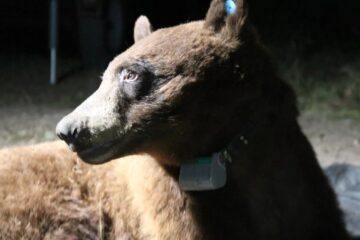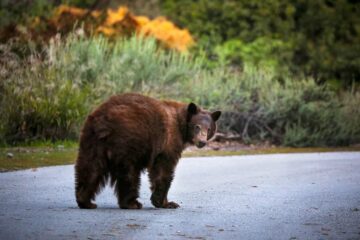Out of the fire
Since the Topanga blaze, suburbia has gone wild with new, unusual residents.
Source of this article – Los Angeles Times, November 22, 2005
By Veronique de Turenne, Times Staff Writer
Deer racing past families frantically packing cars. Cougars fleeing burning brush. Coyotes and bobcats darting down suburban streets, ignoring scores of squirrels, rats and rabbits. The Topanga fire, which this fall burned more than 24,000 acres across parts of the Santa Monica Mountains and the Simi Hills, forced wild creatures to flee the blaze — and take refuge in suburbia. It was nature gone nuts, with all its inflexible hierarchies of predator and prey rendered meaningless in the face of a greater threat.

A deer walks on a hillside near Stonyford, Calif., after a 2001 blaze destroyed 12,000 acres. Wildfires including this fall’s Topanga blaze, which burned 24,000 acres in the Santa Monica Mountains and Simi Hills, leave animals homeless, causing them to flee to human terrain. (Dick Schmidt / AP)
The move is temporary, biologists say. Residents near the footprint of the fire report changes in wildlife patterns. Drawn by isolated islands of green in the burned landscape, wild creatures have become, by turns, fascinating, unwelcome and sometimes alarming.
As winter rains come and burned areas leaf out, most animals will return to their home ranges. Some, however, will adapt to their new habitat, making the suburbs a bit wilder.
“Animals that aren’t injured in the fire will flee,” said Ray Sauvajot, a National Park Service ecologist based in Agoura Hills. “The larger ones move out and as they do, they’ll temporarily lose their habitat and prey.”
With development encroaching on open space in the region, the only place for wildlife to go is into human terrain. For Jim High of Oak Park, this has meant unexpected encounters with coyotes.
“I was near the library when this coyote comes walking across the road in broad daylight,” High said. “It’s been a long while since I’ve seen one around there, and that was usually at dusk.”
Jean Cope, manager of the Oak Park Garden Project and an avid birder, has seen a striking increase in the number and variety of birds. Yellow finches, titmice, juncos and wrens have cleaned out her feeders in record time. A scrub jay, its head and feet burned in the fire, has made her garden its new home. A family of woodpeckers who lost the tree in which they stored their food have turned a nearby light pole into their new granary.
“There’s a bobcat too, one with a radio collar around it’s neck, that I saw in one of the culverts near the house,” Cope said.
Insect life in Oak Park has made a drastic shift as well. According to Adriane Lubin, president of the Oak Park Garden Project, scores of praying mantises and grasshoppers have moved into her yard.
“You see them every day, big ones, longer than your finger,” she said.
Residents on the northeastern edge of the fire zone have also seen significant change.
“During the fire, bunnies were throwing themselves at the windows of the house,” says Carol Sokol, a resident of Bell Canyon, a gated community of about 800 homes where coyote, deer, roadrunners and rabbits are often seen in the steep, oak-studded hills.
Since the fire, the Sokol residence has been invaded by rats. She sees them in the yard and hears them scrabbling at night on the roof. What’s missing, however, are coyotes.
“For weeks after the fire, the coyotes were gone, no sounds, no sightings,” she said. “It was strange. They’re a big part of the canyon and I missed hearing them.”
Gary Hale, a 20-year resident of Bell Canyon, also noticed the shift. “Rabbits and squirrels — so many of them,” he says. “And a fox…. It came creeping out of the brush, and I saw it slip under a trailer at a construction site.”
He too misses the coyotes.
“You don’t hear them howling at night,” Hale says. “Where’d they go?”
They’ve gone hunting, says Gary Busteed, a field biologist. Whereas the scorched landscape hinders some animals, for others it creates a buffet table of opportunity.
“It’s easy pickings,” Busteed says. “Before the land has even cooled, the ravens are in there, eating dead things from the fire.”
For coyotes and bobcats, the lack of underbrush makes stalking rodents and rabbits, their preferred prey, that much easier. In the weeks after a fire, predators may temporarily expand their hunting ranges as they take advantage of the sudden bounty.
“Every time there’s a fire, this is what happens,” Busteed says.
But, he says, though the inland-to-sea patterns of Southern California’s wildfires are ancient, the increasing frequency of these catastrophic events is purely modern.
“Fire’s part of the landscape but in a healthy environment, it doesn’t happen as frequently as we’re seeing it happen today,” he says. “What are the long-term effects? Nobody knows.”


